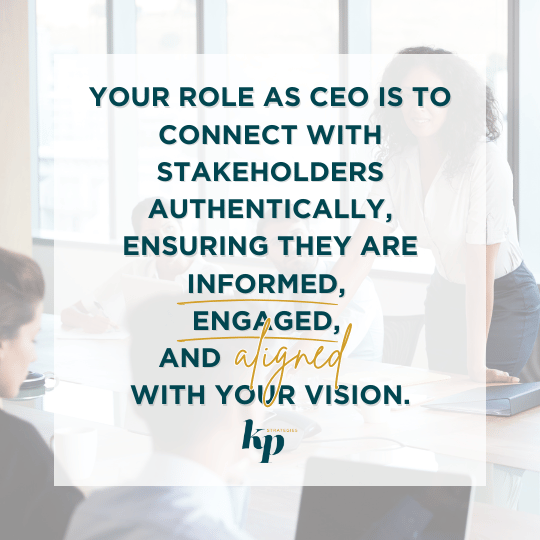
Early in his tenure as CEO, Mark faced a challenge many leaders encounter—he had a bold vision for growth, but the company wasn’t gaining traction. Investors were hesitant, employees were disengaged, and key partners weren’t fully bought in. Frustrated, Mark found himself asking: Why isn’t my message resonating?
Then, during a conversation with a seasoned board member, the insight hit him: It’s not about what you say—it’s about how well your stakeholders feel heard, valued, and connected to your vision.
From that moment, Mark shifted his focus. He prioritized building authentic relationships, engaging directly with key stakeholders, and fostering trust through transparency. Within a year, his company saw a remarkable transformation—employees were energized, investors increased their support, and strategic partnerships flourished. His secret? A relentless commitment to Stakeholder Engagement—one of the six critical responsibilities only a CEO can own.
Why Stakeholder Engagement is a Game Changer
A company does not succeed in isolation. Strong stakeholder relationships provide the foundation for growth, innovation, and resilience. According to McKinsey, companies that actively engage stakeholders outperform their competitors in both profitability and long-term success.
When CEOs commit to meaningful engagement, they unlock:
✅ Stronger alignment – When stakeholders understand and believe in the vision, execution accelerates.
✅ Enhanced agility – In times of uncertainty, trusted relationships provide support and adaptability.
✅ Greater influence – Industry leaders and partners open doors to new opportunities and elevate brand credibility.
✅ Sustained growth – Stakeholder commitment fuels investment, innovation, and strategic momentum.
But effective engagement requires more than surface-level interactions—it’s about creating shared value and long-term trust.
How to Engage Stakeholders for Maximum Impact
1. Clarify Your Vision and Strategy
If stakeholders don’t understand your vision, they can’t support it. Ensure your strategy is clear, compelling, and consistently communicated. Alignment begins with a shared understanding of success.
Ask yourself: Does every key stakeholder know where we’re going and how we’ll get there?
2. Prioritize the Right Stakeholders
Not all stakeholders require the same level of engagement. Identify who has the greatest influence on your company’s success—board members, employees, investors, customers, and key industry leaders—and invest in building those relationships.
Strategy tip: Segment your stakeholders and tailor your approach to their unique needs.
3. Build Personal, Authentic Connections
Mark learned firsthand that CEOs can’t delegate relationships. A personal lunch with an investor, a candid conversation with a board member, or a recognition moment with employees can make all the difference. Genuine connections create lasting trust.
Question to consider: Are you personally engaging with the stakeholders who matter most?
4. Create Feedback Loops
Engagement is a two-way street. Listening is just as powerful as speaking. Establish mechanisms—surveys, advisory meetings, one-on-ones—to gather insights and demonstrate that stakeholder voices drive action.
Key principle: People support what they help create. Are you actively listening and adapting based on stakeholder input?
5. Be Transparent and Consistent
Trust is built through honesty. Share wins, acknowledge challenges, and communicate progress with transparency. Stakeholders will stay engaged when they feel informed, even during tough times.
CEO challenge: Are you communicating regularly, or only when you need something?
6. Play the Long Game
Stakeholder engagement isn’t a “check-the-box” exercise—it’s a continuous commitment. The best CEOs nurture relationships before they need them, ensuring a foundation of trust when challenges arise.
Mindset shift: Engage proactively, not reactively. Strong relationships today will be your greatest asset tomorrow.
Avoid These Common Pitfalls
🚫 Over-delegation – While teams can support, key relationships (board members, investors, strategic partners) require your direct involvement.
🚫 One-size-fits-all approach – Tailor communication and engagement based on stakeholder priorities.
🚫 Short-term thinking – Stakeholders see through transactional relationships. Invest in long-term trust.
The CEO’s Ultimate Advantage
When Mark made stakeholder engagement a top priority, he didn’t just strengthen relationships—he transformed his company’s trajectory. By fostering trust, aligning interests, and ensuring every stakeholder felt connected to the vision, he unlocked new opportunities, mitigated risks, and positioned his company for sustained success.
As CEO, this isn’t just a responsibility—it’s a strategic imperative.
The real question isn’t whether you should prioritize stakeholder engagement—it’s whether you can afford not to.